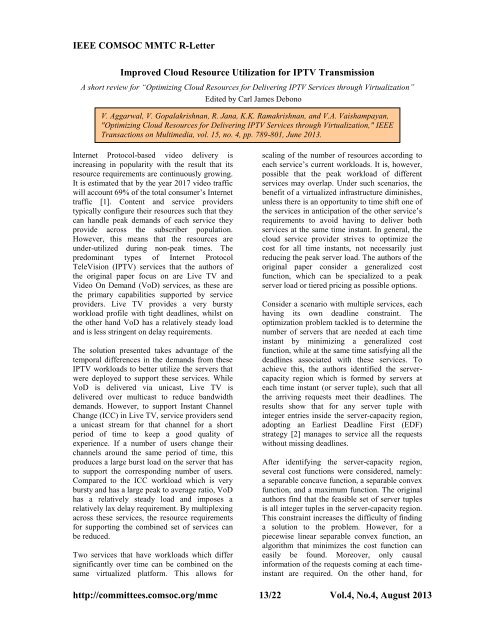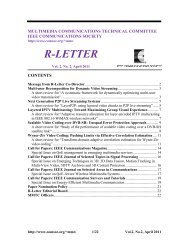R-letter of August 2013 - IEEE Communications Society
R-letter of August 2013 - IEEE Communications Society
R-letter of August 2013 - IEEE Communications Society
- No tags were found...
Create successful ePaper yourself
Turn your PDF publications into a flip-book with our unique Google optimized e-Paper software.
<strong>IEEE</strong> COMSOC MMTC R-LetterImproved Cloud Resource Utilization for IPTV TransmissionA short review for “Optimizing Cloud Resources for Delivering IPTV Services through Virtualization”Edited by Carl James DebonoV. Aggarwal, V. Gopalakrishnan, R. Jana, K.K. Ramakrishnan, and V.A. Vaishampayan,"Optimizing Cloud Resources for Delivering IPTV Services through Virtualization," <strong>IEEE</strong>Transactions on Multimedia, vol. 15, no. 4, pp. 789-801, June <strong>2013</strong>.Internet Protocol-based video delivery isincreasing in popularity with the result that itsresource requirements are continuously growing.It is estimated that by the year 2017 video trafficwill account 69% <strong>of</strong> the total consumer’s Internettraffic [1]. Content and service providerstypically configure their resources such that theycan handle peak demands <strong>of</strong> each service theyprovide across the subscriber population.However, this means that the resources areunder-utilized during non-peak times. Thepredominant types <strong>of</strong> Internet ProtocolTeleVision (IPTV) services that the authors <strong>of</strong>the original paper focus on are Live TV andVideo On Demand (VoD) services, as these arethe primary capabilities supported by serviceproviders. Live TV provides a very burstyworkload pr<strong>of</strong>ile with tight deadlines, whilst onthe other hand VoD has a relatively steady loadand is less stringent on delay requirements.The solution presented takes advantage <strong>of</strong> thetemporal differences in the demands from theseIPTV workloads to better utilize the servers thatwere deployed to support these services. WhileVoD is delivered via unicast, Live TV isdelivered over multicast to reduce bandwidthdemands. However, to support Instant ChannelChange (ICC) in Live TV, service providers senda unicast stream for that channel for a shortperiod <strong>of</strong> time to keep a good quality <strong>of</strong>experience. If a number <strong>of</strong> users change theirchannels around the same period <strong>of</strong> time, thisproduces a large burst load on the server that hasto support the corresponding number <strong>of</strong> users.Compared to the ICC workload which is verybursty and has a large peak to average ratio, VoDhas a relatively steady load and imposes arelatively lax delay requirement. By multiplexingacross these services, the resource requirementsfor supporting the combined set <strong>of</strong> services canbe reduced.Two services that have workloads which differsignificantly over time can be combined on thesame virtualized platform. This allows forscaling <strong>of</strong> the number <strong>of</strong> resources according toeach service’s current workloads. It is, however,possible that the peak workload <strong>of</strong> differentservices may overlap. Under such scenarios, thebenefit <strong>of</strong> a virtualized infrastructure diminishes,unless there is an opportunity to time shift one <strong>of</strong>the services in anticipation <strong>of</strong> the other service’srequirements to avoid having to deliver bothservices at the same time instant. In general, thecloud service provider strives to optimize thecost for all time instants, not necessarily justreducing the peak server load. The authors <strong>of</strong> theoriginal paper consider a generalized costfunction, which can be specialized to a peakserver load or tiered pricing as possible options.Consider a scenario with multiple services, eachhaving its own deadline constraint. Theoptimization problem tackled is to determine thenumber <strong>of</strong> servers that are needed at each timeinstant by minimizing a generalized costfunction, while at the same time satisfying all thedeadlines associated with these services. Toachieve this, the authors identified the servercapacityregion which is formed by servers ateach time instant (or server tuple), such that allthe arriving requests meet their deadlines. Theresults show that for any server tuple withinteger entries inside the server-capacity region,adopting an Earliest Deadline First (EDF)strategy [2] manages to service all the requestswithout missing deadlines.After identifying the server-capacity region,several cost functions were considered, namely:a separable concave function, a separable convexfunction, and a maximum function. The originalauthors find that the feasible set <strong>of</strong> server tuplesis all integer tuples in the server-capacity region.This constraint increases the difficulty <strong>of</strong> findinga solution to the problem. However, for apiecewise linear separable convex function, analgorithm that minimizes the cost function caneasily be found. Moreover, only causalinformation <strong>of</strong> the requests coming at each timeinstantare required. On the other hand, forhttp://committees.comsoc.org/mmc 13/22 Vol.4, No.4, <strong>August</strong> <strong>2013</strong>
















